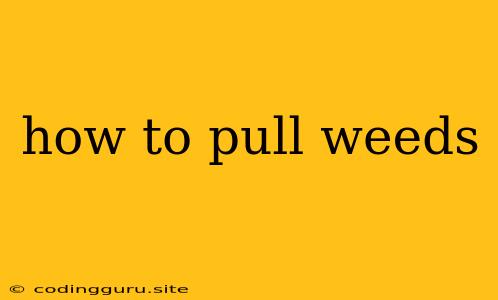How to Pull Weeds: A Comprehensive Guide for Gardeners
Weeds, those unwelcome guests in our gardens, can quickly overpower our beloved plants and ruin the aesthetic appeal of our green spaces. But fret not, dear gardeners! Pulling weeds is a necessary evil, and with the right tools and techniques, it can be a manageable task. Let's delve into the world of weed removal and equip you with the knowledge to reclaim your garden's beauty.
Why Should We Pull Weeds?
Why are weeds so persistent? They thrive in areas where other plants struggle, often competing for resources like sunlight, water, and nutrients.
What are the consequences of neglecting weeds? They can:
- Choke out desirable plants: Weeds can block sunlight, preventing your flowers and vegetables from flourishing.
- Spread diseases and pests: Some weeds act as hosts for harmful insects and diseases, potentially affecting your entire garden.
- Create an eyesore: Weeds can turn a beautiful garden into an unsightly mess.
Getting Ready to Pull: Essential Tools and Techniques
1. Timing is Key: The best time to pull weeds is when the soil is moist, making it easier to loosen them from the ground. Avoid pulling weeds after a heavy rain, as the soil will be too wet and sticky.
2. Tools of the Trade:
- Hand trowel: A trusty hand trowel is a must-have for digging out weeds with deep roots.
- Weeding fork: This tool is excellent for loosening compacted soil and removing weeds with shallow roots.
- Gloves: Protect your hands from thorns, dirt, and potential allergic reactions.
- Garden hose: Keep a hose nearby for watering your plants after weeding.
3. The Art of Pulling:
- Identify the weed: Learn to recognize common weeds in your region to determine the best removal method.
- Dig deep: Aim to remove the entire root system, including the taproot for taproot weeds. Leaving root fragments behind can lead to regrowth.
- Remove with care: Pull weeds gently, avoiding excessive tugging that could damage nearby plants.
- Dispose properly: Throw weeds in a sealed bag to prevent seed dispersal.
Dealing with Different Weed Types
1. Annual Weeds: These weeds complete their life cycle in one season. Removing them before they produce seeds is crucial.
2. Perennial Weeds: These weeds have a longer lifespan, often with underground storage organs (rhizomes, bulbs, etc.). Removing the entire root system is essential.
3. Creeping Weeds: These weeds spread horizontally, forming dense mats.
- Tip: For creeping weeds, try using a hoe to slice through their roots and prevent them from spreading.
Preventive Measures: Keep the Weeds at Bay
1. Mulch: Applying a layer of mulch around your plants helps suppress weed growth by blocking sunlight and preventing seed germination.
2. Competition: Planting dense ground cover or companion plants can help outcompete weeds.
3. Hand-Weeding: Regular hand-weeding can prevent weeds from establishing themselves.
4. Pre-Emergent Herbicides: For stubborn weeds, consider using pre-emergent herbicides, which prevent weed seeds from germinating. Note: Use these cautiously and follow label instructions.
Conclusion
Weeding is an ongoing task in any garden, but it's a rewarding one. By understanding the different types of weeds, using the right tools, and implementing preventive measures, you can keep your garden free from unwanted invaders and ensure a flourishing space for your beloved plants. Remember, patience and persistence are key!
